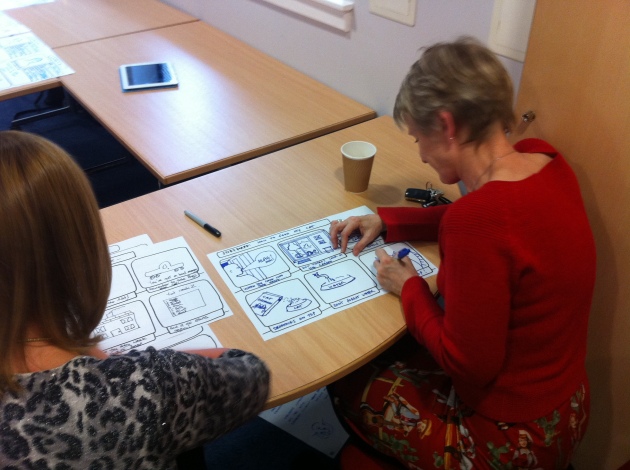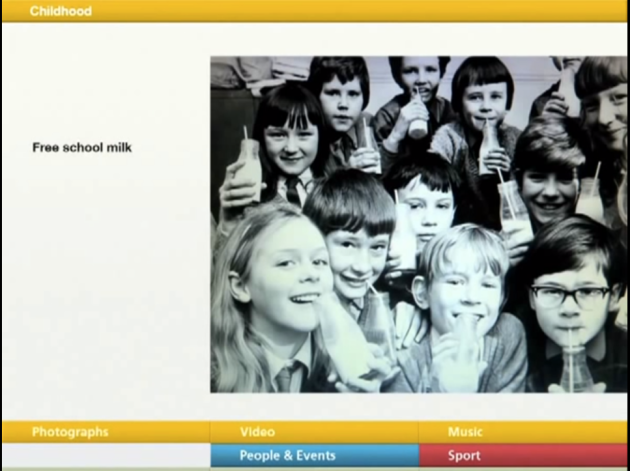I met up with Sara Nevay and Rebecca Lindsay today to have a chat about the work they did on ‘DeMEntia diary’, an electronic tool which will be further explained in this post. This was the second meeting I’ve had so far to find out more about designing for dementia, to further my dissertation research. Here is what we talked about:
What exactly is the dementia diary?
The SSSC, Alzheimer’s Scotland, IRISS, and 100% open ran a two day innovation event called ‘Workforce of the future’ which was all about staff giving ideas about new strategies which they thought would improve the care system. The ideas were all submitted to an online portal and then staff were able to vote on which ideas they thought were strongest. Twenty of the suggestions online were then taken to the event and the person who had submitted an idea presented it to the group. Based on these presentations another vote was cast to take the best ideas forward. One idea was for a visual diary that utilise technology to tell stories about people with dementias lives. It was partially a reminiscence tool but also a useful way to communicate things about that person to care workers. The diary would be able to give a new group of carers a snapshot of the person’s life, how they like things to be done for example how they like their tea.
The Scottish Borders Council and Alzheimer’s Scotland were interested in taking the idea further and both had different ideas about how they would use the tool. Who could benefit? How would it be implemented?
In London Sara Nevay ran an empathy exercise – staff were asked to make up personas based on people they care for and storyboard tasks their personas may have to perform. One of the staff members had a medical background and their storyboard was about visiting the doctor and showing them the diary so they could assess how the patients condition was progressing. The idea here was that family members who are constantly with the patient may not be objective about changes in the patients life or the progression of the illness. The diary could show the patient performing a certain task multiple time over the course of a month and it would show any deterioration in dexterity or comprehension. There was some question about whether people would be able to use the technology s there was a suggestion to also have a paper version available. Much like the ‘This is me’ booklet produced by Alzheimer’s UK.
The service would be beneficial both to the person with the illness and to their family. The diary would preserve part of the person’s personality. With more developed dementia the person you knew before is not there anymore and it’s important to have things to remember them by.
How did you both get involved with the project?
The people running the event contacted Hazel White who runs the master of design for services at DJCAD, which we were both doing at the time. They wanted ten designers to come along and participate as visualisers. We were to help pull ideas together and produce visuals but ended up facilitating the groups.
Four months later five of the ideas chosen in the innovation event had received extra funding to take them further. 100% open bowed out and we became the design team. They wanted us to pack together all of the information gathered and tie it together.
In the Borders Becca Lindsay gave homework for everyone to do. She asked them to make a video in the context of what the service would be. One person took it a bit further and actually filmed a lady with dementia who she cared for. The lady was adamant that she wanted her wardrobe to be filmed as she was very into fashion and her carers never quite got her outfit’s right. She wanted the video to show which combinations she liked to wear her clothes in, which cardigan went with which blouse and so on. This was a new conversation for the woman, which stimulated conversation. Being in this new situation made her brain work differently, helping to combat the symptoms of her illness. Breaking the loop of the same questions day in day out can be really helpful for people with dementia. It can be monotonous and it’s hard to break the cycle.
There were some complexities working in the borders such as the poor Internet signal and the out-dated technology that people use there. People were not at ease with utilising technology, one woman was adamant that she wouldn’t do it. However the next day she came back in having experimented and had several videos to show. Overcoming the terror of new technology is rewarding and makes people want to engage once they have gotten the hang of it.
Becca’s grandmother had dementia and went through a cycle for three months telling the same story over and over. Then one day a police officer came to the door to explain about an issue with the neighbours and that there might be some noise. Becca insisted he came in to tell her gran and when he did her manner changed completely, saying how charming he was. His visit broke the loop and improved the mood. Breaking the loop benefits the family as well as the person with the illness
What part did research play in this project?
It was very much a live project. It wasn’t necessary for us to do research, everyone we were working with was already an expert in this field so we were just bringing the design to it. People who really knew what they were doing had agreed upon the base of the idea. Someone who really thought it would be useful had suggested it.
What is reminiscence therapy and how did it play a part?
Reminiscence therapy can use a physical object, photos, music or even smells to bring back memories and ignite conversation. It’s all about nostalgia. An object can be linked to a happy memory. Short-term memory goes but often memories from ten or more years ago are really fresh. Recalling these memories can change a person’s frame of mind. With reminiscence therapy the memories don’t always last but the sense of wellbeing and happiness can stay. Certain memories are much stronger than others.
It can be difficult for people who caught their dementia later on as they will forget that they have been diagnosed which can cause distress. The vast changes that have been made to the city can also cause distress. A person with dementia will remember how things look years ago and so the city is not familiar to them. None of the shops or buildings are what they remember.
Did you speak to anyone who had the illness?
Sara – In the second session Alzheimer’s Scotland brought in people who had been working with different studies pertaining to dementia strategies. There was one man who had been diagnosed late on. He had been wandering off in the middle of the night and waiting for the newspaper in the morning. It wasn’t until his wife woke up one night to find he wasn’t there. When he wasn’t in a period of memory loss he knew what his diagnosis was. He had been very independent prior to the illness, running his own business. He had been involved with Cobalt run by St Andrews University. The programme helps people with dementia to relearn forgotten skills. He had been learning to type and do other admin type jobs that he had done when he was working. Relearning these skills improved his memory and he is now able to give lectures for 40 odd minutes. Relearning a physical activity is a huge help to the brain.

The main things which I picked up on during my chat with Sara and Rebecca were; the importance of reminiscence, both for the person with dementia and for their families. Short term memory is often the most affected so thinking back to a time in the past can be easier, recalling old memories can improve someone’s mood. It is also important for families to have a way of remembering their relative as a person which can become difficult when the illness is more progressed and has an affect on behaviours. Simultaneously it is really crucial to know a person’s habits and preferences when caring for them, as in the case of the lady with the fabulous wardrobe. Making small alterations in the way you care for someone and help them with day to day tasks can improve their well being and happiness. I think it’s also really interesting to hear the impact re-learning lost skills can have on the memory. I think that is a vital thing to take forward in my research.
Thankyou very much to both Sara Nevay and Rebecca Lindsay for meeting up with me to have a chat.





















































